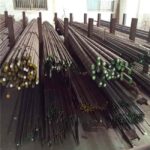347 347H 1.4550 1.4961 Stainless Steel
Alloy 347 (UNS S34700) is columbium stabilized austenitic stainless steel plate with good general corrosion resistance and somewhat better resistance in strong oxidizing conditions than 321 (UNS S32100). It has excellent resistance to intergranular corrosion after exposure to temperatures in the chromium carbide precipitation range of 800 – 1500°F (427 – 816°C). The alloy has good oxidation resistance and creep strength to 1500°F (816°C). It also possesses good low temperature toughness.
Alloy 347H (UNS S34709) stainless steel is the higher carbon (0.04 – 0.10) version of the alloy. It was developed for enhanced creep resistance and for higher strength at temperatures above 1000°F (537°C). In most instances, the carbon content of the plate enables dual certification.
Applications
Chemical Processing
Food Processing – equipment and storage
Petroleum Refining – fluid catalytic cracking units, polythionic acid service
Pharmaceutical Production
Waste Heat Recovery – recuperators
Equivalent grades of steel X6CrNiNb18-10 (1.4550)
| DIN | EU EN |
USA – |
UNS | France AFNOR |
England BS |
Sweden SS |
Russia GOST |
| 1.4550 | X6CrNiNb18-10 | 347 | S34700 | Z6CNNb18-10 | 347S31 | 2338 | 08KH18N12B |
| 1.4961 | X8CrNiNb16-13 | 347H | S34709 |
Chemical Properties:
| C | Cr | Mn | Ni | P | S | Si | Cb/Ta | |
| 347 | 0.08 max | min: 17.0 max: 20.0 |
2.0 max | min: 9.0 max: 13.0 |
0.04 max | 0.30 max |
0.75 max |
min:10x C max: 1.0 |
| 347H | min: 0.04 max: 0.10 |
min: 17.0 max: 20.0 |
2.0 max | min: 9.0 max: 13.0 |
0.03 max | 0.30 max |
0.75 max |
min:10x C max: 1.0 |
Smelting Option
1 EAF: Electric Arc Furnace
2 EAF+LF+VD: Refined-smelting and vacuum degassing
3 EAF+ESR: Electro Slag Remelting
4 EAF+PESR: protective atmosphere Electro Slag Remelting
5 VIM+PESR: Vacuum induction melting
Forming Option
1 Hot rolling process
2 Hot Forging: Electro-hydraulic; High-speed-hydraulic; Oil-hydraulic; Precision-forging
Heat-treatment Option
1 +A: Annealed (full/soft/spheroidizing)
2 +N: Normalized
3 +NT: Normalized and tempered
4 +QT: Quenched and tempered (water/oil)
5 +AT: Solution annealed
6 +P: Precipitation hardened
Suface Option
1 Black Surface
2 Grounded: Bright but rough ; Not precision
3 Machining for plate: Bright and precision; Little turning scar
4 Peeled/Turned: Bright and precision; Little turning scar
5 Polished: Very Bright and precision size; Not turning scar
Other Services
1 Cutting: Small pieces
2 CNC Machine: Produce as your drawing
3 Package: Bare/Nylon/Canvas/Wooden
4 Payment:T/T, L/C, O/A(request credit)
5 Transport:FOB/CFR/CIF/DDU/DDP (train/ship/Air)
Mechanical Properties:
| Grade | Tensile Strength ksi (MPa) min | Yield Strength 0.2% ksi offset ksi (MPa) min | Elongation (% in 50mm) min | Hardness (Brinell) MAX | Hardness (Rockwell B) MAX |
| 347/347H | 75 (515) |
30 (205) |
40 | 201 | 95 |
Corrosion Resistance
Alloy 347 stainless steel plate exhibits good general corrosion resistance that is comparable to 304. It was developed for use in the chromium carbide precipitation range of 800 – 1500°F (427 – 816°C) where un-stabilized alloys such as 304 are subject to intergranular attack. In this temperature range, the overall corrosion resistance of Alloy 347 stainless steel plate is superior to Alloy 321 stainless steel plate. Alloy 347 also performs somewhat better than Alloy 321 in strongly oxidizing environments up to 1500°F (816°C).
The alloy can be used in nitric solutions, most diluted organic acids at moderate temperatures and in pure phosphoric acid at lower temperatures and up to 10% diluted solutions at elevated temperatures. Alloy 347 stainless steel plate resists polythionic acid stress corrosion cracking in hydrocarbon service. It can also be utilized in chloride or fluoride free caustic solutions at moderate temperatures.
WELDABILITY
Austenitic stainless steels are considered to be the most weldable out of all high alloy steels
Can be welded by all fusion and resistance welding processes
HEAT TREATMENT
Annealing temperature range is 1800 to 2000°F
May be stress relief annealed within the carbide precipitation range of 800 to 1500°F without any danger of subsequent intergranualr corrosion
Cannot be hardened by heat treatment

